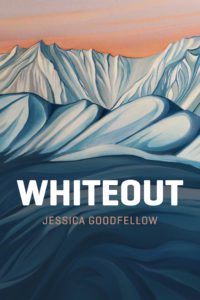
Jessica Goodfellow’s Whiteout (University of Alaska Press, 2017) is a moving collection about the disappearance of the poet’s uncle during the 1967 Wilcox climbing expedition on Denali. The collection melds what is known about that event and the emotional repercussions for the surviving family members, with meditations on nature, time—both geologic and personal—and death. Goodfellow explores these themes in a way that recalls the early nineteenth century fascination with the sublime, a fitting philosophical mode for her subject matter. Meanwhile, her deft use of craft and formal methods create a style and tone that serves her subject matter well, and creates emotional weight without exploiting the dramatic, macabre circumstances of her uncle’s disappearance
The book is organized in three main sections—“Disaster,” “Aftermath,” and “Glacial Erasure”— separated by several longer poems that stand alone. The sections move in roughly chronological order, dealing most prominently with the circumstances of her uncle’s disappearance during the Wilcox expedition in “Disaster,” then moving through the aftermath and ensuing meditations. Throughout the collection, Goodfellow employs a variety of forms and formal strategies that reveal her facility with craft. Whiteout contains poems constructed of couplets, quatrains, a series of nocturnes, a pantoum, and a list poem. In “Phantom Pantoum,” Goodfellow uses the repetitive lines of the form to strong effect while narrating the history of the disaster: “my uncle was suddenly everywhere, epic uncle of everyone” is one of these lines, and provides a glimpse of what it must be like to have a loved one suddenly and briefly famous for a tragic reason.
Sound and wordplay are other prevalent tools of craft on display in Whiteout. Goodfellow’s use of repetition of sounds through alliteration, assonance, and repeated phonemes such as “un” and “cle” woven into the titles of numerous of the poems, is expert:
In the either of ether or ice
he became not himself but his body.
He froze or he fell—in the never
of knowing we pitch our tents.
In a series of brief, finely honed poems pulled together under the title “Ten Variations on a Weight-Bearing Air,” Goodfellow explores death through the disintegration of the body using anatomical terms like muscle and sinew, but also employs the language of mathematics. She uses homophones—bear and bare; weight, wait and await; air, heir, and err—to provide texture, sonic interest, and the “variations” promised us in the title. The poems themselves are brief musings that echo the book’s larger themes:
The first-ever headstones
had heft meant for holding
down the dead, as though
the living did not trust their own
memories.
The longest poem in the “Variations” sequence is a meditation on algebra, which I will quote here in its entirety:
Whoever
translated algebra
not as
________a branch of mathematics in which arithmetical operations and
________relationships are generalized by using alphabetic symbols to represent
________unknown…members of specified sets…
_________________________________________________________(unknown…members)
nor as
_______the science of restoring what is missing and equating like with like
_________________________________________________________(what is missing)
but as
_______the reunion of broken parts—
whoever it was that made that facile choice
_________________________________________________________(like with like)
find her
and break her
The most direct translation of al-jabr from Arabic (Latinized and imported to English as “algebra”) is “reunion of broken parts.” Goodfellow’s poem, like her book, wants to balance the emotional occasion with the distance of abstraction, preferring the first, operational, textbook definition, or the second version, which is close to the Arabic title of the first book on the subject, to the simpler, more direct, and most poetic definition. Coming as it does between the more narrative first section and more meditative second section the book, “Variations” provides a nexus for the collection’s themes.
The book’s second section, “Aftermath,” focuses on the repercussions of the family’s loss and lack of closure about the circumstances of his death, and is the most emotionally weighted portion of the book. The circumstances of her uncle’s demise—a team of twelve climbers, seven of whom perished, their bodies never found—comprise the content of several poems, though the majority extend into explorations of grief, the age and mystery of the mountain, and even particle physics. Goodfellow takes the reader through the her grandparents’ mourning in poems such as “K Street Hangout”—“Instead, all that returned to you was / your sturdy, engineless grief”— and “Quaking Aspen:”
_________________how beautiful ___Bartok, Mozart
to dream of feet upon the mountains_______ ___of him
his feet upon the mountains
________________yellow ochre
oldest living things, trembling roots____ entwined.
In this poem, longing for the past is conveyed through the grandmother’s emotional touchstones, her own history of familial loss, and her memories of her lost son.
The final section of the book, “Glacial Erausre,” moves away from the familial and toward examination of the sublimity of the mountain juxtaposed against history. It also introduces us to the community near Denali. The section title and several poems within also examine the melting of the glacier as a consequence of climate change. In one chilling moment, the poet wonders whether her uncle’s body will be unfrozen and revealed as the glacier thaws. The mountain’s sublimity, its danger and beauty, are juxtaposed against the small town of Talkeetna, the last human outpost before the mountain.
This is the town that says the last good-bye
to mountaineers headed for Denali.
Climb high, sleep low is the unofficial motto:
the wooden figures embody one end of that spectrum.
The graves below disembody the other.
The image of the carved pole in the graveyard serves as a straightforward and ever-present reminder of the paradox of the climb: achievement of a goal on the one hand, with the threat of great risk on the other. The carved pole also implies the intersection of cultures in this town near Denali, though Goodfellow does not emphasize this point.
The poems in Whiteout pull together an array of topics and well-developed craft, making it a complex book emotionally, thematically, and technically. Goodfellow’s skill in weaving these elements into a coherent whole amplifies the book’s emotional power and creates a haunting look at a personal tragedy that resonates with larger philosophical questions about death, grief and the dangers of the earth’s extremes.
***
Author photograph © Janne Rytkonen.





